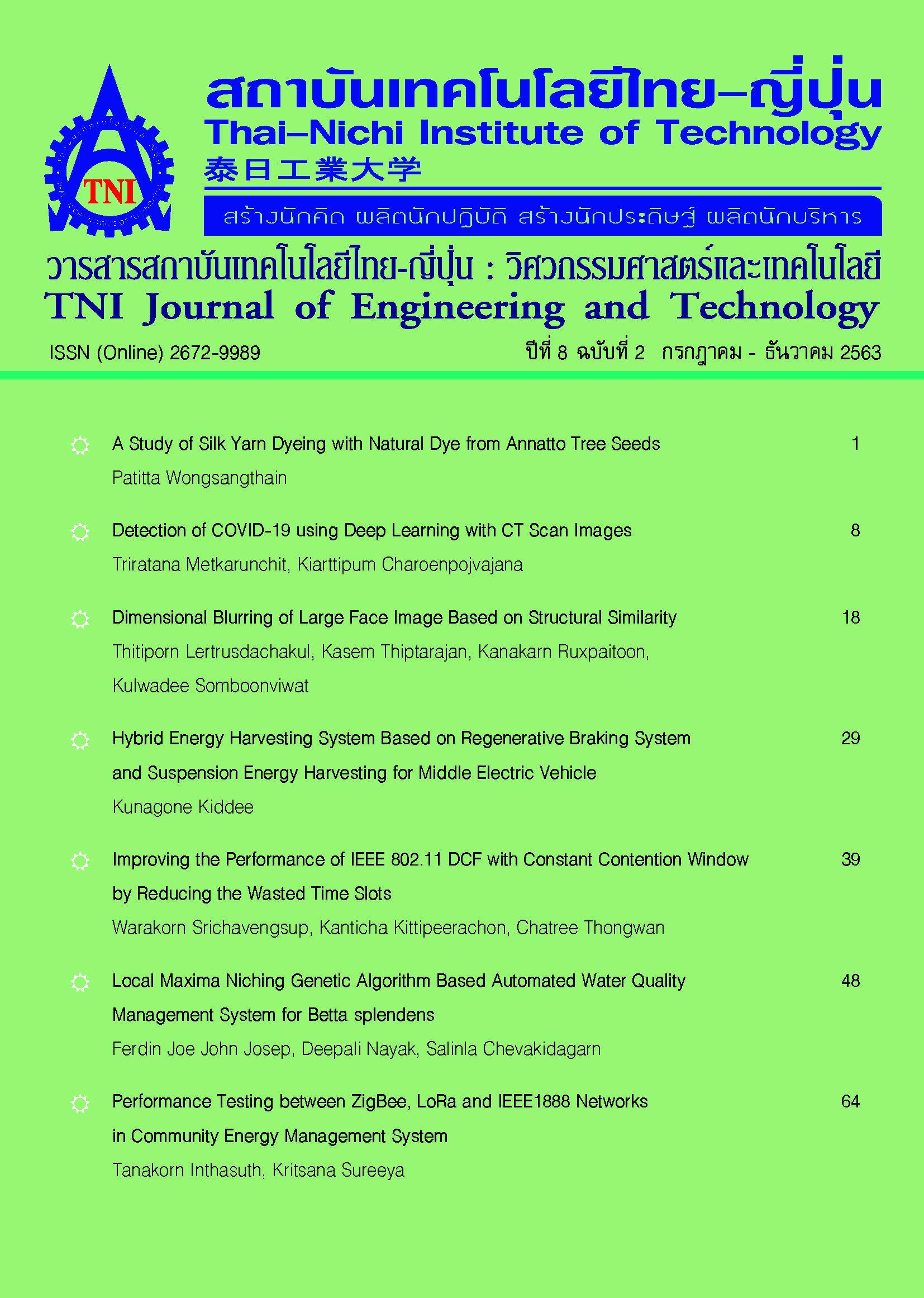A Study of Silk Yarn Dyeing with Natural Dye from Annatto Tree Seeds
Main Article Content
Abstract
The purposes of this study were to investigate chemical properties, colour properties, colour fastness to washing and light as well as the comparing silk yarn dyeing from annatto seed extract with laboratory process. The research process included chemical measurement, wavelength measurement of the extract, silk yarn dyeing in the laboratory, color shades measurement with CIELAB, the test of color fastness to washing and light, and the color comparing between dyeing in the model and in the laboratory. Findings indicate that annatto seed extract was acid as its average pH 4.37 and composed of tannin, a phenolic compound, structured as disubstituted hydroxy aromatic (o – para hydroxyl aromatic) and anthraquinone, as a flavonoid compound. The color of the silk yarn after dyeing with annatto seed extract was orange – yellow with brightness (L*) was between 73.01 and 73.53 as the result of dyeing with Ca 4%, Alum 0.01% and the annatto seed extract. The red – green (a*) was between 31.80 and 32.17 and most of which was red as the result of dyeing with Ca1%, Alum 0.05% and the annatto seed extract. The yellow- blue (b*) was between 63.92 and 64.64 and most of which was yellow as the result of dyeing with Ca 1%, Alum 0.025%, and annatto seed extract. The colour fastness to washing of the dyed silk yarn was good meanwhile the colour fastness to light was between fair and good. The colour properties of dyeing in the model was not different from one in the laboratory.
Article Details
Article Accepting Policy
The editorial board of Thai-Nichi Institute of Technology is pleased to receive articles from lecturers and experts in the fields of engineering and technology written in Thai or English. The academic work submitted for publication must not be published in any other publication before and must not be under consideration of other journal submissions. Therefore, those interested in participating in the dissemination of work and knowledge can submit their article to the editorial board for further submission to the screening committee to consider publishing in the journal. The articles that can be published include solely research articles. Interested persons can prepare their articles by reviewing recommendations for article authors.
Copyright infringement is solely the responsibility of the author(s) of the article. Articles that have been published must be screened and reviewed for quality from qualified experts approved by the editorial board.
The text that appears within each article published in this research journal is a personal opinion of each author, nothing related to Thai-Nichi Institute of Technology, and other faculty members in the institution in any way. Responsibilities and accuracy for the content of each article are owned by each author. If there is any mistake, each author will be responsible for his/her own article(s).
The editorial board reserves the right not to bring any content, views or comments of articles in the Journal of Thai-Nichi Institute of Technology to publish before receiving permission from the authorized author(s) in writing. The published work is the copyright of the Journal of Thai-Nichi Institute of Technology.
References
P. Supcharoen, N. Rueng-rangsri, and K. Deewisej, Herbal plants in national parks in central Thailand. Nonthaburi, Thailand:Thai Traditional Medicine Development Foundation Press (in Thai), 2016.
N. Meiphan, S. Rattanadilok, and S. Khunadilok, “Dyeing silk fabric with natural dye from Kaempferia Parviflora Wall. ex. Baker Rhizomes,” (in Thai), Journal of Home Economics, vol. 59, no. 2, pp. 26-35, 2016.
W. Sutaphan, N. Supakan, and Y. Raksakulpiwat, “Study of using Silk as a continuous fiber for reinforcing epoxy composite,” (in Thai), School of Polymer Engineering, Institute of Engineering, Suranaree University of Technology, Nakhon Ratchasima, Thailand, Rep. SUT-7-710-51-24-33, 2012.
P. Pimpraporn, “A Study of effects of various mordants added to the dye extraced from litsea glutinosa (Lour.) Leaves on color shades of dyeing silk thread through exhaustion dyeing process,” (in Thai), M. Eng. thesis, Department of Textile Engineering, Rajamangala University of Technology Thanyaburi, Pathum Thani, Thailand, 2015.
R. Chochai, P. Chochai, and M. Taweepol, “The cotton yarn natural dyeing with dyes from red cotton bark for small scale industry,” (in Thai), Kamphaeng Phet Rajabhat University, Kamphaeng Phet, Thailand, Rep. 20191212095948, 2010.
Good practices for degumming and dyeing silk yarn, Thai Agricultural Standard TAS 8204-2018, Apr. 2018. [Online]. Available: https://www.acfs.go.th/standard/download/GMP-DEGUMMING-AND-DYEING-SILK-YARN.pdf.
M. Kumaresan, N. Palanisamy, and P. Kumar, “Application of ecofriendly natural dye on silk using combination of mordants,” (in Thai), International Journal of Chemistry Research, vol. 2, no. 1, pp. 11-14, 2011.
N. Yosyingyong, Improvement of color fastness and shades cotton fabric dyed with natural dye. Bangkok, Thailand: Rajamangala University of Technology Krungthep, (in Thai), 2014.
R. Chochai and P. Chochai, “A Study of Nano Zinc Oxide Using for the Cotton Yarn Dyeing from the Natural Dyes,” (in Thai), The Golden Teah: Science and Technology Journal, vol. 4, no. 2, pp. 59-70, 2017.


